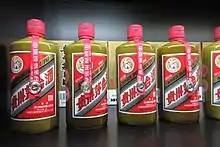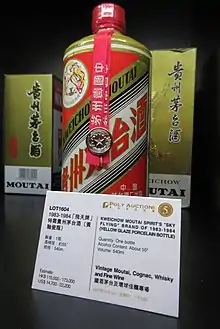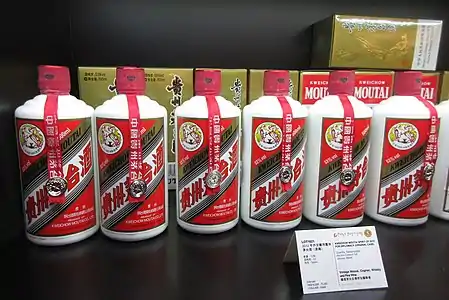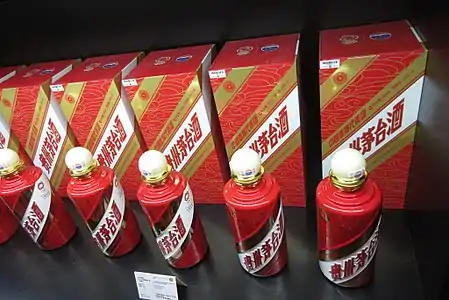Maotai
Maotai or Moutai (simplified Chinese: 茅台; traditional Chinese: 茅臺; pinyin: máotái) is a style of jiangxiang baijiu made in the town of Maotai, Guizhou Province, China. Maotai is made with few ingredients (sorghum, a wheat based qū, and water from the Chishui River) and uses traditional Chinese techniques of fermentation, distillation, and aging, to produces a spirit with a unique nutty, grain forward, and in many ways savory aroma and flavor.[1][2]
 | |
| Type | Baijiu, Jiangxiang |
|---|---|
| Manufacturer | Kweichow Moutai, and others |
| Country of origin | China |
| Region of origin | Guizhou |
| Introduced | Qing Dynasty |
| Alcohol by volume | 38%-53% |
| Colour | Clear |
| Ingredients | Sorghum |
| Maotai | |||||||||||||||||||
|---|---|---|---|---|---|---|---|---|---|---|---|---|---|---|---|---|---|---|---|
| Simplified Chinese | 茅台 | ||||||||||||||||||
| Traditional Chinese | 茅臺 | ||||||||||||||||||
| Hanyu Pinyin | Máotái | ||||||||||||||||||
| |||||||||||||||||||
The most famous and certainly best selling manifestation of maotai is produced by Kweichow Moutai, so successful in fact that it has become the most valuable spirits brand not just in China but in the world as a whole.[3] However, despite common misconception, Kweichow Moutai is not the only producer of maotai, nor do they own any exclusive right to the name. Maotai must simply be produced in the town of Maotai and follow the production guidelines as laid out in regulation.
History
Alcohol production in Zunyi, on the banks of the Chishui River, has a long history dating back to at least the 1st and 2nd cenutries BCE where there is record of Han dynasty Emperor Wu tasting and praising a goquijiu produced in Yelang. However, it wasn't until the Tang and Song dynasties that grain based distilled alcohols began to develop in China as a whole.[4][5]
The origins of Maotai itself, and the distilleries that preceded Kweichow Moutai lie in the Qing dynasty when Beijing officials of the salt monopoly, stationed at an outpost in Maotai, introduced baijiu production methods from the north (qingxiang) which ultimately merged with the then in-use methods from neighboring Sichuan (nongxiang).[6] The result of this blend of techniques served as the basis for jiangxiang baijiu and more particularly for maotai itself. The earliest explicit record of maotai is in 1704, where in Renhuai Caozhi, a local newspaper, it was written that "Moutai Village in the west of the city ranks first in the whole country for making liquor."[5]
In 1854, during the Taiping Rebellion the town of Maotai was destroyed and all of the distilleries reduced to ruins or abandoned completely. Nine years later, in 1863 a salt merchant from a neighboring town bought one of the abandoned distilleries, hired a retired master distiller, and resumed the production of maotai in the newly founded "Chengyi" distillery and sixteen years later, in 1879, three Renhuai landlords opened the "Ronghe" distillery. It's with these two distilleries that many of the techniques and profiles of contemporary maotai were finalized. At the beginning of the 20th century, with the fall of the Qing dynasty and the birth of the Republic of China, maotai continued to be in demand with "tribute liquor" being crafted at the request of the short lived Chinese leader Yuan Shikai for the occasion of his coronation as emperor. In that same year, maotai was presented at the 1915 Panama-Pacific Exposition and awarded a Gold Medal[7] at the 1915 Panama-Pacific Exposition which spurred a rapid increase in demand for the spirit within China and in response a rapid increase of production capacity for the two distilleries. In 1929 the third distillery "Hengxing" was founded and it is on the foundation of these three distilleries that Kweichow Moutai was to be built.[5]
Maotai's importance in contemporary China has many of its roots in the era of the Chinese Civil War. It was in Zunyi, the prefectural city over the town of Maotai that Mao Zedong was first elected as leader of the Communist Party of China and it was during the Long March that many Chinese troops and many of China's future leaders, including Zhou Enlai would gain an appreciation for maotai.[4][6] Stories from the time recount Red Army soldiers and officers enjoying maotai both for consumption and for more practical purposes, primarily the cleaning and disinfection of the soldiers feet.[8] In "Memoirs of the Long March" the author Cheng Fangwu wrote; “Because of the urgent military situation, we dared not drink much liquor. The liquor was mainly used to wipe our feet and relieve fatigue on the road. Wiping feet with the maotai is effective. Everyone praises it."[9] In a likely apocryphal story, company commander Wang Yuenan, and one of Mao's guards Chen Fengchan, were in returning from a trip to purchase maotai for this very purpose when they ran into Mao himself who told them; "Maotai is a place famous for its wine, but it would be a pity to wipe your feet with this wine!"[4] While in the town of Maotai during the Long March, the political bureau of the Red Army issued a notice to the passing soldiers to note the importance of maotai liquor and refrain from interfering in the private distillation of the spirit ongoing except to buy or sell.[8]
Shortly after the end of the Chinese Civil War and after the founding of the modern People's Republic, the three existing maotai distilleries, Chengyi, Ronghe, and Hengxing were merged to create the modern, state-owned Kweichow Moutai in 1951.[10]
Since the foundation of the modern Kweichow Moutai, the spirit has served as part of the standard fare for Chinese diplomatic meetings and dinners. From Mao's gifts of maotai given to Joseph Stalin and Kim Il-Sung in 1950 and 1973 respectively,[5] to Zhou Enlai's use of the spirit as a diplomatic tool for the 1954 Geneva Conference[11] and the welcoming banquet for Richard Nixon 1972 visit to China,[12][13] maotai has served as one of the primary cultural items representing China on the international stage.[14] Its use in these terms has become so well known that when Deng Xiaoping visited the United States in 1979, Henry Kissinger told him "I think if we drink enough Moutai we can solve anything."[14]
Gallery
 A bottle of Maotai produced in 1983-1984 has an estimated price range of HK$115,000-173,000 (US$14,700-22,200) in an auction in Hong Kong in 2017.
A bottle of Maotai produced in 1983-1984 has an estimated price range of HK$115,000-173,000 (US$14,700-22,200) in an auction in Hong Kong in 2017. Vintage Maotai in the more common white porcelain bottles displayed in the same auction.
Vintage Maotai in the more common white porcelain bottles displayed in the same auction. Maotai in red special version bottles
Maotai in red special version bottles
References
- Sandhaus, Derek (19 August 2014). "Unearthing China's Ancient Terroir in Maotai". punchdrink.com. PUNCH.
- Sandhaus, Derek (4 March 2019). "Better Know a Baijiu: Sauce Aroma". drinkbaijiu.com. Drink Baijiu: The World of Chinese Spirits.
- "Brandirectory Spirits 50 2023".
- "Explaining the history of Moutai". ce.cn (in Simplified Chinese). China Economic Net. 17 May 2007.
- "China's No. 1 Liquor, the earliest Maotai liquor in the Siheyuan Art Museum". toutiao.com (in Simplified Chinese). Jinri Toutiao. 17 April 2022.
- Sandhaus, Derek (31 May 2014). Baijiu: The Essential Guide to Chinese Spirits. Penguin Group. pp. 102–105. ISBN 9780143800132.
- Grand Prize (Best of Class)
Medal of Honor (95-100 points)
Gold Medal (85-94 points)
Silver Medal (75-84 points)
Bronze Medal (60-74 points)
Honorable Mention (without medal):
"1915 San Francisco Panama-Pacific International Exposition Award Medals". EXPOMEDALS.com. Archived from the original on 2015-01-17. Retrieved 2015-02-24. - "Did the Red Army soldiers really wash their feet with Maotai wine during the Long March?". xinhuanet.com (in Simplified Chinese). Xinhua News Agency. 18 August 2016.
- Cheng, Fangwu (1977). Memoirs of the Long March (in Simplified Chinese). People's Publishing House. ISBN 978-7010056128.
- "About Moutai>Development History". china-moutai.com (in Simplified Chinese). Kweichow Moutai Group Co. Ltd.
- Liu, Gang (11 December 2019). "Look, this is the earliest existing Kweichow Moutai!". cnwinenews.com (in Simplified Chinese). China Wine News.
- "Moutai expands into mainstream U.S. market". chinadaily.com.cn (in Simplified Chinese). China Daily. 24 May 2018.
- MacMillan, Margaret (2007). Nixon and Mao: The Week That Changed the World. New York: Random House. pp. 149–150. ISBN 9781400061273.
- Mark Macdonald (July 3, 2012). "One Chinese Liquor Brand Is the Life of the Party". International Herald Tribune. Retrieved 2012-07-03.